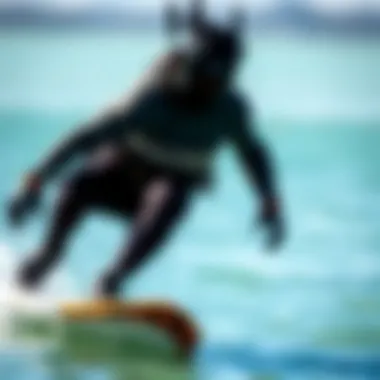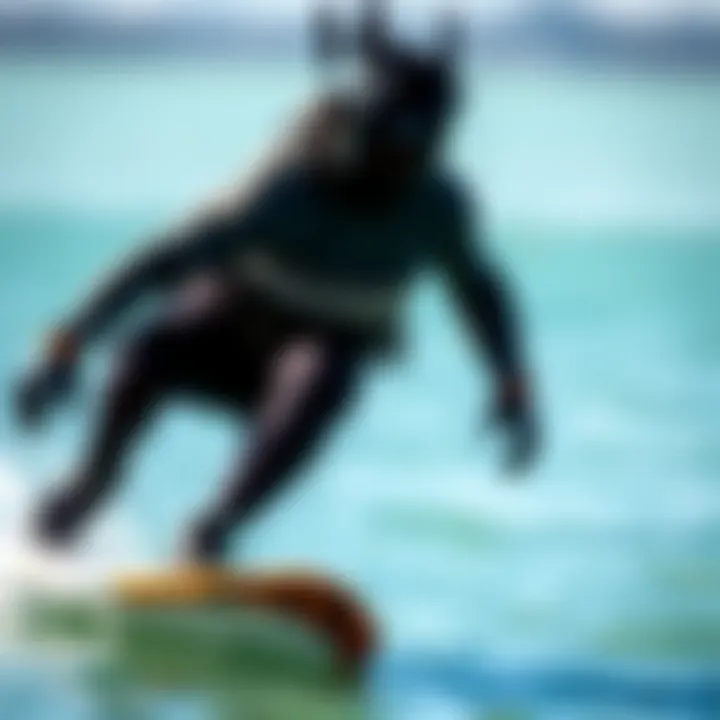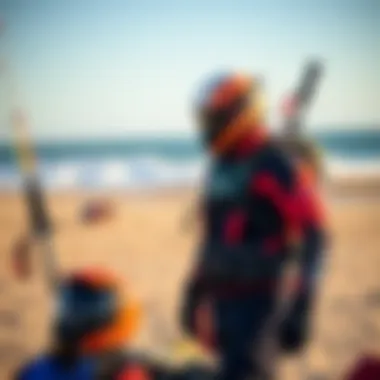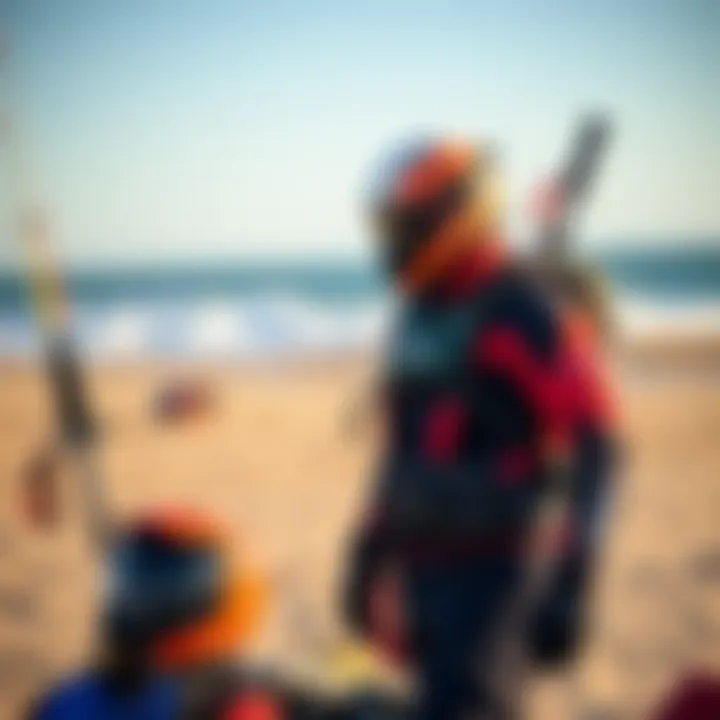Ultimate Guide to Choosing the Best Dry Suit for Kiteboarding


Intro
Kiteboarding is more than just a sport; it's a lifestyle filled with adrenaline and a connection to nature. But as thrilling as riding the waves can be, it’s crucial to equip yourself with the right gear, especially when it comes to staying dry. Enter the dry suit—an essential investment for kiteboarders who want to thrive in various water conditions.
Choosing the right dry suit can significantly impact your comfort and safety, allowing you to focus on enjoying the ride rather than worrying about the elements. In this guide, we will explore the intricate details of the top dry suits available in the market, covering key features, the importance of materials, and the perfect fit. We’ll also dive into care tips and comparisons of leading brands, ensuring you have the knowledge you need for a sensible purchasing decision.
Whether you’re just starting or are an experienced kiteboarder looking to upgrade your gear, this article is designed to help you navigate the often overwhelming options available. With insights and tips tailored for enthusiasts, instructors, and adventurous spirits alike, you’re in for a comprehensive look at what makes a dry suit not just an accessory, but a necessity in the world of kiteboarding.
Understanding Dry Suits
Understanding dry suits is crucial for kiteboarders who wish to maintain their comfort and safety while navigating through various water conditions. As a kiteboarder, the right gear not only impacts your performance but also your overall experience on the water. Dry suits, specifically designed for extreme wet conditions, should be an integral part of your kiteboarding arsenal.
Definition and Purpose
A dry suit is a specialized type of protective clothing that keeps the wearer dry even in the toughest water conditions. Unlike wet suits, which allow some water to permeate and be trapped between the suit and the skin, dry suits prevent water from entering entirely. They are typically equipped with seals at the neck, wrists, and ankles to ensure that no water gets inside. This makes them ideal for kiteboarders who may find themselves frequently splashed or submerged in cold water.
The primary purpose of a dry suit is to provide a barrier against chilling water, enhancing warmth and comfort. This is especially important during cooler months or in regions where temperatures can drop significantly. By keeping you dry, a dry suit helps maintain your body temperature and avoids conditions like hypothermia.
Advantages of Using a Dry Suit
Choosing to wear a dry suit comes with several advantages that can significantly enhance your kiteboarding experience:
- Temperature Regulation: A dry suit allows you to kiteboard in colder weather without the constant worry of getting wet and chilled. Staying dry means you can enjoy longer sessions without discomfort.
- Versatility: Many dry suits come with features that enable easy layering. You can wear thermal layers underneath for extra warmth in freezing waters, offering flexibility in different conditions.
- Protection From Elements: Dry suits are often made from durable materials that protect against water, wind, and even abrasions if you crash into a rough surface. This ensures that both your gear and skin are safeguarded during your runs.
- Enhanced Mobility and Comfort: With advancements in dry suit design, modern options focus on mobility. They include articulate joints and stretchable materials allowing for better movement while maintaining warmth.
- Built-in safety features: Many dry suits come with reflective elements or bright colors, making you more visible in the water. Some models also provide buoyancy features that make getting back to the surface easier if an incident occurs.
Key Features to Consider
When diving into the choice of a dry suit for kiteboarding, understanding the primary features becomes essential. These components not only affect the performance and comfort while riding the waves but also play a significant role in ensuring safety across varying water conditions. Considering these factors will help in making an informed decision, leading to an enhanced kiteboarding experience.
Material Types
Neoprene vs. Breathable Fabrics
Neoprene has been a staple in water sports fabrics for many years, known for its insulation properties. However, it can retain moisture, leading to discomfort if water seeps in. On the other hand, breathable fabrics, like Gore-Tex, have been gaining traction. They offer better moisture management, allowing sweat to escape while keeping the water out. The key characteristic of breathable options is their ability to regulate body temperature, making them an attractive choice for kiteboarders who may be in changing weather conditions.
One notable feature of breathable fabrics is their weight; they tend to be lighter than neoprene suits. This added mobility can make all the difference when executing tricks or navigating complex maneuvers on the water. Still, it's crucial to remember that neoprene might provide a better barrier against cold water due to its thicker design.
Durable Water Repellent (DWR) Coating
Having a Durable Water Repellent coating on your dry suit adds a layer of advantage particularly for kiteboarders. This treatment makes the exterior fabric hydrophobic, which prevents water from soaking into the material and adds to the suit's overall durability. DWR enhances the suit’s lifespan in unpredictable weather, acting as a first line of defense against water penetration. The key characteristic of DWR is that it holds onto water droplets, allowing them to roll off instead of saturating the fabric.
However, it’s worth noting that while DWR is beneficial, it can degrade over time and may need to be reapplied. Regular maintenance ensures that the protective layer stays intact, thus prolonging the dry suit's effectiveness in keeping the wearer dry and comfortable.
Seams and Construction
Stitched vs. Taped Seams
The construction of a dry suit's seams is vital for its overall effectiveness against water penetration. Stitched seams are common but can potentially allow some water through, especially if they are not properly sealed. Taped seams, however, provide a waterproof barrier by covering the stitching with a special tape or adhesive. This offers an extra layer of protection, minimizing the likelihood of leaks during a kiteboarding session.
The standout aspect of taped seams is their durability; they generally resist wear and tear better than their stitched counterparts. For avid kiteboarders, this feature can mean the difference between a dry and comfortable day on the water versus one fraught with discomfort due to water seepage.
Types of Zippers


Zipper selection is another critical element when considering a dry suit. Front zippers make donning and doffing easier, while back zippers provide a cleaner look and sometimes better flexibility. There are also waterproof zippers with special designs that ensure a tighter seal. The practical aspect of zippers in dry suits lies in their functionality. A faulty zipper can undermine the entire suit’s efficiency; hence a robust, well-designed zipper is crucial.
Different suits may come equipped with various zipper types, including plastic or metal, each presenting its advantages and disadvantages. A plastic zipper is generally lighter and corrosion-resistant, while a metal zipper may handle the rigors of wear better but can be heavier. Knowing the type that suits one’s needs is essential for ensuring reliability during kiteboarding adventures.
Fit and Sizing
Importance of Proper Fit
The fit of a dry suit directly influences its comfort level and functionality. A suit that’s too snug may restrict movement, while one that’s too loose can lead to water rushing in, negating the suit’s purpose. Thus, finding the right balance is critical for kiteboarders, especially those who plan to be active or perform tricks.
A beautifully fitted dry suit hugs the body without constricting it, allowing for optimum movement and freedom on the water. Additionally, a proper fit helps in effective insulation, keeping warmth trapped while allowing moisture to escape.
Size Charts and Adjustments
Using size charts is paramount in selecting the correct dry suit. Generic sizes can vary significantly across brands, making it important for kiteboarders to reference specific measurements provided by the manufacturer. Most brands offer detailed size charts that include measurements for chest, waist, hips, inseam, and more.
Sometimes, minor adjustments will still be required, which might involve tailoring or selecting a suit with adjustable features such as ankle or wrist seals. The unique feature of adjustable suits is that they provide extra versatility in achieving a snug fit, catering to changing body types and personal preferences. Taking the extra steps to ensure correct size and adjustments will pay off greatly during those wet and wild kiteboarding sessions.
Top Brands in Dry Suits
When it comes to choosing a dry suit for kiteboarding, the brand can make a significant difference in performance and comfort. Well-reputed manufacturers often bring a wealth of experience and innovation that can enhance your overall kiteboarding adventure. Understanding the unique attributes of leading brands not only aids in finding the right fit but also informs kiteboarders about the technologies and features that stand out in various conditions.
Brand A Overview
Key Products
Brand A has carved a niche in the dry suit market with its innovative designs and durable materials. One of its standout offerings is the Quantum Dry Suit. This model is known for providing excellent insulation while maintaining breathability—crucial for hot and cold weather alike. One unique feature of the Quantum is its internal lining, which adds a layer of comfort against the skin. It tends to be a popular choice for those venturing into colder waters due to its robust thermal protection and flexibility, making it suitable for both intermediate and expert kiteboarders.
User Reviews
User feedback often highlights Brand A's adaptability in harsh water conditions. Many users appreciate the length of the zipper, which allows for easy dressing and undressing, a distinct advantage when compared with other brands. However, some find that sizing can be a bit tricky, as the fits can sometimes be more snug than expected. Overall, the reviews indicate that Brand A products excel in comfort and mobility without compromising on insulation.
Brand B Overview
Key Products
Brand B stands out with its AeroShell Dry Suit, designed with the hardcore kiteboarder in mind. This suit focuses on lightweight materials, allowing for increased agility on the water. One notable characteristic of the AeroShell is its three-layer construction, which not only ensures waterproofness but also enhances flexibility for dynamic movements. Users frequently mention that this suit shines in warmer conditions, as it prevents overheating while still providing ample protection against splashes and unexpected downpours.
User Reviews
Reviewers have noted that the fit of the AeroShell is often described as 'almost custom-made,' thanks to its adjustable cuffs and many size options. However, some early adopters pointed out that wear and tear on seams can become an issue after extensive use. Nevertheless, the feedback highlights a balance between flexibility, lightweight feel, and waterproof capability as the reasons it remains a popular choice among kiteboarders.
Brand Overview
Key Products
When it comes to versatility, Brand C's FlexGuard Dry Suit often leads the charge. Many kiteboarders rave about its high-stretch fabric that allows for a wide range of movements. Additionally, its ergonomic design is particularly effective in reducing drag, making it a favored option in competitive kiteboarding scenarios. One distinct advantage is the suit’s built-in UV protection, perfect for long sessions under the sun. This feature gives kiteboarders confidence to stay out longer without risking sunburns.
User Reviews
Customer reviews frequently spotlight the three-quarter zipper, which simplifies entry while minimizing the risk of water leakage, a common concern in traditional full zippers. However, some users have expressed concerns about durability, particularly in intensive use situations. Yet, countless others appreciate the comfort level it provides, making it suitable not just for kiteboarding but also for other water sports.


"Choosing the right dry suit is a matter of blending personal needs with what different brands offer. Don't just go for a name; dig into what makes each suit tick!"
Comparative Analysis of Popular Dry Suits
Understanding the landscape of dry suits on the market is no small feat. For kiteboarders, a thorough comparative analysis becomes essential in ensuring optimum performance and safety. As water sports enthusiasts know, the right dry suit can mean the difference between a pleasant day on the waves and a chilly nightmare. Evaluating different suits allows kiteboarders to make an informed decision, factoring in durability, comfort, and cost-effectiveness.
Durability and Performance
When it comes to kiteboarding, durability should be at the top of your list. Dry suits are expected to face harsh conditions—think saltwater, UV exposure, and potential abrasions from equipment. High-quality materials are non-negotiable for surviving these challenges.
A dry suit that’s worth its salt will feature robust seams, and many manufacturers employ specialized stitching techniques or taping to safeguard against leaking. For instance, look for suits made with reinforced panels in high-wear areas; they might increase upfront costs but can save you a bundle in the long run from repairs and replacements.
Also, consider the performance of the suit in terms of breathability. A suit that retains moisture inside can become uncomfortable quickly. Brands like Ocean Rodeo excel in their use of breathable materials, allowing for released perspiration while keeping cold water at bay.
"Durability isn’t just about toughness; it’s about consistent performance over time."
Comfort and Mobility
Another crucial aspect is comfort. When you're zipping through waves, the last thing you want is to feel restricted. A well-fitted dry suit should fit like a second skin, offering freedom of movement for those quick turns and jumps. Look into suits that provide articulated joints, such as knee and elbow darts that allow for full range of motion without excessive bulk.
Additionally, assessing comfort extends beyond the fit. It’s worth considering features like adjustable seals and reflective zippers that provide greater ease and comfort while putting the suit on or taking it off. For instance, the Mystic Stealth has been praised for its flexibility due to 4-way stretch panels, making it a favorite from the beginner to the pro.
Price vs Value
When a kiteboarder looks at a dry suit, the price tag can stir up mixed feelings; after all, kiteboarding already demands financial investments. However, it’s crucial to weigh price against value.
A cheaper suit may lure you with its lower cost, but if it sacrifices durability or comfort, it might have you splashing out for repairs or replacements in no time. Conversely, high-end suits might seem pricey initially but can offer features and longevity that justify the investment. Consider this:
- A well-made dry suit encourages longer sessions in the water, making every ride well worth the price.
- Keep an eye out for any seasonal sales or discounts from reputable retailers.
Balancing your budget with your needs is about identifying what you’re purchasing. It’s not just a suit; it’s your ticket to enjoying those windy sessions without a hitch.
By diving into the comparative analysis of dry suits, you arm yourself with the knowledge needed to make the right choice. It’s no longer just about picking the first option you find; it’s about meeting your specific needs as a kiteboarder on the water. For further reading, sources like Wikipedia and Britannica can provide broader insights into materials and their applications in water sports.
Caring for Your Dry Suit
Taking proper care of your dry suit extends its lifespan and effectiveness. Kiteboarding can be a rough sport, exposing your gear to saltwater, sand, and UV rays. These elements can wear down fabrics and seals, so maintaining your suit is not just about keeping it clean; it’s essential for ensuring you stay dry and comfortable on the water. Neglecting care can lead to leaks or reduced thermal protection, which can have serious consequences during a chilling session riding the waves.
Cleaning and Maintenance
Cleaning your dry suit may not be the most exciting task, but it's crucial. After each use, especially if you’ve been in saltwater, rinse your suit with fresh water. Give it a good soak to remove salt residues that can corrode the materials. Follow these steps for an effective cleaning routine:
- Rinse Immediately: As soon as you finish kiteboarding, take the time to rinse your dry suit. Use cold freshwater to avoid damaging the fabric.
- Gentle Cleaning Agent: If necessary, use a mild soap. Avoid fabric softeners or bleach which can degrade the material.
- Hand Wash: Gently scrub with a soft sponge or cloth, paying special attention to the neck and wrist seals, where salt and grime tend to build up.
- Thorough Rinsing: Ensure all soap is rinsed out. Soap residues can irritate your skin during your next session.
It’s also wise to check the zippers and seals regularly. Lubricating them with a zipper-specific lubricant helps prevent them from sticking or breaking. Furthermore, inspect the seams for any signs of wear or separation. A little proactive maintenance can save you from a potentially chilly session due to leaks.
Storage Recommendations
When it comes to storing your dry suit, treat it like the precious gear it is. The way you store your suit affects its longevity and ability to perform well when you need it. Keep these tips in mind:
- Hang it Up: After cleaning, hang your dry suit on a wide hanger, preventing creases and folds that can damage the fabric over time.
- Cool, Dry Place: Store your suit in a shady, cool spot. Avoid direct sunlight which can degrade the materials, especially the seam glue.
- Avoid Heavy Objects: Don’t pile heavy items on top of your suit, as they can create pressure points and damage the seams.
- Breathable Bag: If you need to store it for a long period, consider putting it in a breathable mesh bag to avoid any moisture buildup.


By following these simple yet vital steps, not only can you maximize the life of your dry suit, but you also enhance your overall kiteboarding experience. A well-maintained suit means comfort and safety on those unforgettable days out on the water.
Remember, investing time in care now saves you money and hassle later. Don’t skimp on maintenance; your dry suit will thank you!
For more in-depth information on garment care, check out sources like Wikipedia on Textile Care or visit forums on Reddit where fellow kiteboarders share their insights.
Safety Considerations
When it comes to kiteboarding, safety isn’t just a suggestion; it’s an absolute necessity. Understanding safety considerations before you hit the water can mean the difference between a thrilling ride and a potential disaster. Since kiteboarding often places enthusiasts in unpredictable conditions, any gear that minimizes risk is worth its weight in gold. A well-chosen dry suit can protect against sudden changes in temperature, the risks of hypothermia, and enables you to stay buoyant in rough waters.
Here are a few elements to consider as you prioritize safety in your kiteboarding adventures:
- Temperature Regulation: Staying dry is essential to maintaining your body heat when conditions turn chilly.
- Buoyancy: Quality dry suits can assist in keeping you afloat if you end up in the water unexpectedly.
- Emergency Preparedness: Understanding how your gear functions can aid in responding to emergencies more effectively.
With all of this in mind, let's dive deeper into the critical aspects of hypothermia prevention and necessary emergency protocols.
User Experiences and Testimonials
Understanding how other kiteboarders feel about their dry suits can offer valuable shortcuts to informed purchasing decisions. Each rider's experience is shaped by personal preferences, skill levels, and the conditions they encounter. For beginners, hearing from seasoned veterans can bridge the gap between confusion and clarity when selecting a dry suit. For experts, sharing insights contributes to a community of knowledge that fosters safety and enjoyment on the water.
Beginner Perspectives
For those just dipping their toes into the world of kiteboarding, the choice of a dry suit can seem daunting. Novice riders tend to lean on recommendations from more seasoned participants. Hearing firsthand stories helps demystify what might appear as a technical jargon fest.
A common experience shared among beginners is how a well-fitted dry suit can boost confidence while navigating the unpredictable waves. Riders often report that their initial discomfort faded quickly once they found a suit that truly complemented their body type and riding style. Even the skeptics—who thought they could get away with summer gear—realized the true necessity after a few soggy sessions.
"I thought I could start kiteboarding in just a wetsuit. But after one bloody cold session, I quickly learned about dry suits. Best decision ever!"
– Newbie rider, Lucy
Having direct insights into how dry suits perform in reality helps incoming riders avoid rookie mistakes, like ignoring ventilation during warm humid days which can be a sweat fest! Many newbies share experiences where they regretted not investing more time or resources into understanding their options. They wished they had listened more closely to experienced kiteboarders who had their fair share of swim bouts!
Expert Insights
The insights from expert kiteboarders tend to focus less on the emotional aspects and more on the nitty-gritty technicalities of dry suits. Pro riders often reveal critical features that enhance performance, such as the importance of breathable fabrics. They discuss specific measurements that might cause minor inconveniences if overlooked, such as cuff fit or zipper accessibility—all things that might seem less important until you’re out riding.
Many veteran riders emphasize the significance of dry suits during extreme conditions. They share experiences where less-than-ideal gear could have led to serious risks. This perspective not only adds depth but serves as a cautionary tale for less experienced riders who might underestimate the relevance of a quality dry suit.
For example, one staunch advocate, Alex, recalls the treacherous conditions he faced at a well-known kiteboarding location.
"I was out on some gnarly waves, and I knew I was in deep. But thanks to my reliable dry suit, I came out unscathed. Trust me, choosing the right suit is a matter of safety as much as it is comfort."
– Expert rider, Alex
Through these testimonials, both beginner perspectives and expert insights illuminate the path for kiteboarders looking to enhance their experience and safety on the water. The shared knowledge and experiences form a community bond that can make all the difference between a good day on the water and one filled with regrets.
Finale: Making the Right Choice
When it comes to choosing the ideal dry suit for kiteboarding, the stakes are high. Your comfort, safety, and overall experience on the water hinge on selecting the right gear. In this final section, we’ll delve into the critical aspects that should guide your decision making. Choosing the right dry suit is not just about strolling into a store and picking whatever is on sale; it's a process that requires careful consideration of several factors such as materials, fit, and specific features that align with your unique needs.
This is particularly essential for kiteboarders who frequently expose themselves to various weather conditions. A well-fitting dry suit can mean the difference between a great day on the water and an uncomfortable, even dangerous, situation. Furthermore, understanding the offerings from leading brands can help in weighing personal requirements against a suit's capabilities, leading to informed decisions that enhance enjoyment and safety while kiteboarding.
Recap of Key Points
- Material Matters: Choosing between options like neoprene and breathable fabrics can greatly influence both comfort and warmth.
- Seams and Construction: The type of seams and zippers play a significant role in durability and functionality, ensuring that your suit remains watertight during riding.
- Fit and Sizing: Not only is it crucial that the suit fits well for improved mobility, but comfort is also a substantial factor in avoiding chaffing and restricting movement.
- Caring for Your Suit: Regular maintenance and proper storage prolong the life of your suit, keeping it in prime condition for your adventures.
- Safety Considerations: Always be aware of conditions that could lead to hypothermia. Familiarizing yourself with emergency protocols ensures that you are prepared for anything.
Final Recommendations
Opting for the right dry suit can elevate your kiteboarding adventures to new heights. Here are some actionable tips as you prepare to make your purchase:
- Try Before You Buy: Whenever possible, try on different suits to gauge comfort and mobility.
- Invest in Quality: It’s often worth stretching your budget a tad for a suit from a reputable brand that is known for durability and performance.
- Read User Reviews: Your peers can offer unique insights that online specs cannot. Tapping into kiteboarding forums like Reddit can also provide useful feedback on specific models.
- Consider Your Environment: Reflect on the conditions you will be kiting in most frequently. This can help zero in on features that matter most.
- Maintenance Matters: Don’t skimp on the care for your suit. A little maintenance goes a long way in keeping your suit efficient and lasting.
Ultimately, making an informed choice about the right dry suit will not only enhance your comfort and safety but will also ensure that each kiteboarding session is as thrilling and enjoyable as possible.















